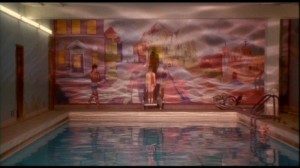White of the Eye (1987)
 [The following was written as an overview for the audience for a screening of Donald Cammell’s White of the Eye. It was not intended as an extended analysis, merely some background for a bound-to-be-confused theater of patrons.]
[The following was written as an overview for the audience for a screening of Donald Cammell’s White of the Eye. It was not intended as an extended analysis, merely some background for a bound-to-be-confused theater of patrons.]
In the late 1980s, as Golan-Globus Productions began to overextend themselves, certain projects fell by the wayside. Golan-Globus, run by Menahem Golan and and Yoram Globus, had attempted to take over the Superman franchise away from Warner Brothers and producers Alexander and Ilya Salkind, and had lured Christopher Reeve back for a fourth film if they agreed to finance one of his pet projects (which became Street Smart).
 Narrowly escaping their creditors for years, despite healthy profits from working with Charles Bronson and Chuck Norris (and many ninja films) through the 1980s, Golan-Globus and their distribution arm, Cannon Films always had ambitions of producing artier fare to go along with their exploitation successes. In 1987, as Superman IV: The Quest for Peace was in production, the bottom fell out, and Golan-Globus cut the sequel’s budget from $36 million to $17 million. At the same time, they had some other respectable titles ready to come out, like Norman Mailer’s Tough Guys Don’t Dance and Donald Cammell’s White of the Eye.
Narrowly escaping their creditors for years, despite healthy profits from working with Charles Bronson and Chuck Norris (and many ninja films) through the 1980s, Golan-Globus and their distribution arm, Cannon Films always had ambitions of producing artier fare to go along with their exploitation successes. In 1987, as Superman IV: The Quest for Peace was in production, the bottom fell out, and Golan-Globus cut the sequel’s budget from $36 million to $17 million. At the same time, they had some other respectable titles ready to come out, like Norman Mailer’s Tough Guys Don’t Dance and Donald Cammell’s White of the Eye.
Neither film made much of a dent (though Mailer’s film has maintained a cult following based on its pure ineptitude), but at least Cammell finally got to make a film with the least interference he had experienced. Previously known as both a painter and the director of Performance, an avant-garde British gangster film from 1970, that featured Mick Jagger and others engaging in graphic sexual experimentation and psychedelic drugs and imagery, and the studio-controlled Demon Seed with Julie Christie, Cammell, along with his wife China Kong, were allowed to make White of the Eye as long as they kept the budget low.
 The film contains all of the technical playfulness that producers had prevented on Demon Seed and on Cammell’s final film, Wild Side, which left Cammell so distraught that he committed suicide. White of the Eye is told through a fractured timeline, with flashbacks, flash forwards, and flash frames, amidst a mix of classical music and a techno-ish score that sounds like an off-shoot of Tangerine Dream (Risky Business, Thief). The film’s woozy, overlit photography and its high contrast colors contribute to the off-kilter feel of the movie, as home theater installer David Keith battles his demons that may or may not have led to his becoming a serial killer in an upscale Arizona town. Utilizing both Navajo and Giallo imagery (Giallo is a very stylized genre of Italian crime thrillers), Cammell walks the line that Golan-Globus would have appreciated, somewhere between exploitation and art.
The film contains all of the technical playfulness that producers had prevented on Demon Seed and on Cammell’s final film, Wild Side, which left Cammell so distraught that he committed suicide. White of the Eye is told through a fractured timeline, with flashbacks, flash forwards, and flash frames, amidst a mix of classical music and a techno-ish score that sounds like an off-shoot of Tangerine Dream (Risky Business, Thief). The film’s woozy, overlit photography and its high contrast colors contribute to the off-kilter feel of the movie, as home theater installer David Keith battles his demons that may or may not have led to his becoming a serial killer in an upscale Arizona town. Utilizing both Navajo and Giallo imagery (Giallo is a very stylized genre of Italian crime thrillers), Cammell walks the line that Golan-Globus would have appreciated, somewhere between exploitation and art.



